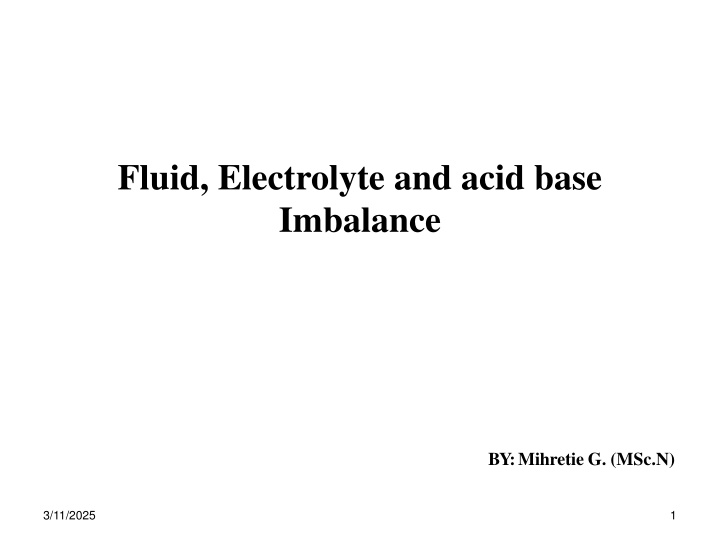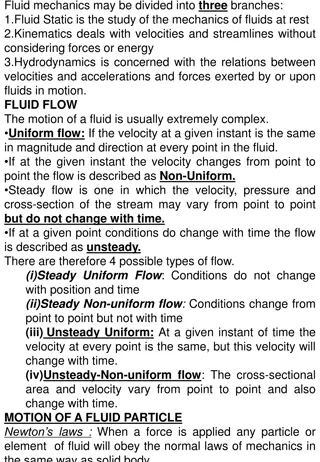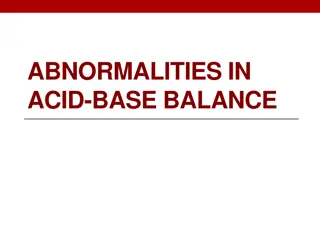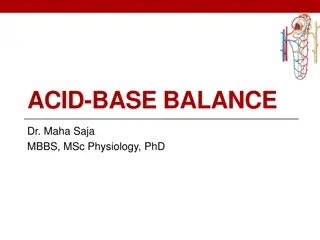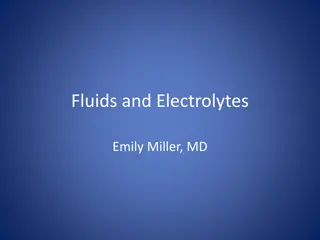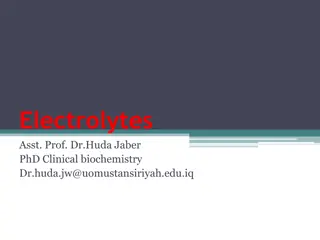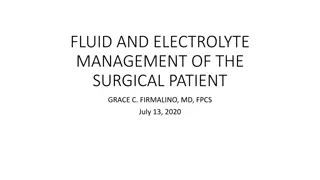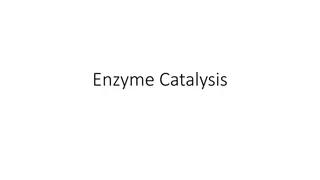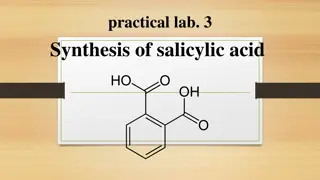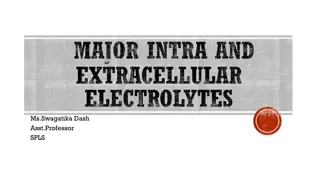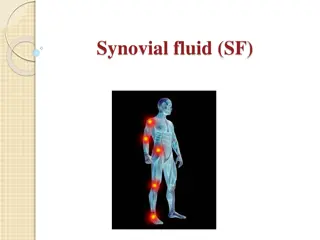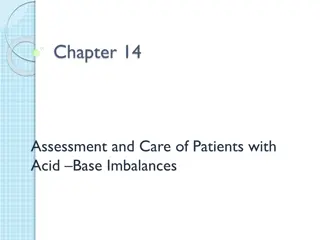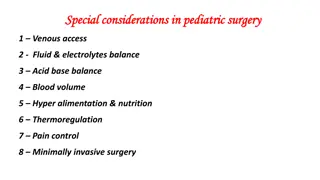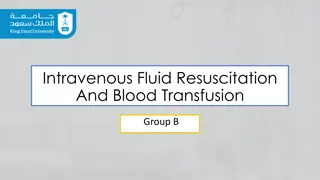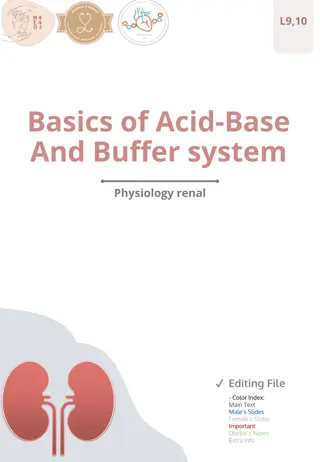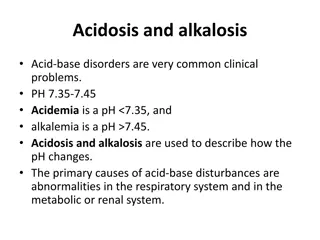Fluid, Electrolyte and Acid-Base Imbalance Overview
This content provides an in-depth exploration of fluid, electrolyte, and acid-base imbalances, covering fundamental concepts, body fluid compartments, fluid shift classifications, and conditions leading to third spacing. Learning objectives include understanding the role of vital organs in regulating the body's fluid balance and managing various imbalances. Explore the content to enhance your knowledge in nursing and healthcare.
Download Presentation

Please find below an Image/Link to download the presentation.
The content on the website is provided AS IS for your information and personal use only. It may not be sold, licensed, or shared on other websites without obtaining consent from the author.If you encounter any issues during the download, it is possible that the publisher has removed the file from their server.
You are allowed to download the files provided on this website for personal or commercial use, subject to the condition that they are used lawfully. All files are the property of their respective owners.
The content on the website is provided AS IS for your information and personal use only. It may not be sold, licensed, or shared on other websites without obtaining consent from the author.
E N D
Presentation Transcript
Fluid, Electrolyte and acid base Imbalance BY: Mihretie G. (MSc.N) 3/11/2025 1
Learning objectives On completion of this chapter, the learner will be able to: Describe the role of the vital organs in regulating the body s fluid composition and volume.. Plan effective care of patients with the following imbalances: fluid volume deficit and fluid volume excess; sodium deficit (hyponatremia)and sodium excess (hypernatremia); potassium deficit (hypokalemia) and potassium excess (hyperkalemia). 3/11/2025 2
Fundamental concepts The human body functions when certain conditions are kept with in a narrow range of normal value. Body temperature Electrolytes Blood PH Blood volume Body fluid contains: water Electrolytes Non electrolytes (glucose, urine), and other substances 3/11/2025 3
Body fluid compartments Approximately 55-60%of a typical adult s weight consists of fluids. These fluids are distributed in to different compartments: Intracellular fluid(ICF) compartment Is fluid with in the cells Located mainly (primarily) in skeletal muscle mass Contains approximately 2/3 (28L)of the total body fluid Constitute 45%of body weight 3/11/2025 4
Extra cellular fluid(ECF) compartment Is fluid outside cells Contains approximately 1/3(15L) of body fluid further divided in to Intravascular space Interstitial space Trans-cellular space 3/11/2025 5
FLUILD SHIFT Is the term used to classify the distribution of water. This is of three types: First space fluid shift normal distribution of fluid Second spacing Is an excess accumulation of interstitial fluid Third spacing Is losing of ECF in to spaces that do not have contribution in the equilibrium of ICF and ECF. 3/11/2025 8
Third spacing occurs in: Ascites Burns Peritonitis Bowl obstruction Massive bleeding in to joint or body cavities 3/11/2025 9
S/S of third spacing ed urine out put ed heart rate ed BP Edema ed CVP ed Body weight Imbalances in fluid intake and out put 3/11/2025 10
Functions of fluid Water provides about 90-93% of the volume in the extra cellular compartment. Its functions include: Providing form for body structures Acts as transport vehicle Aids in the hydrolysis of food Acts as medium and reactant for chemical reactions Acts as a lubricant Cushions and acts as shock absorber 3/11/2025 11
The sources of fluid gains Absorption from GIT Parenterally administered fluids Metabolic oxidation of foods Bathing in fresh water Routs of fluid losses Kidney (1ml/kg/hr in all age groups Insensible loss Skin Lungs Stool (GIT) 3/11/2025 12
Average in take and out put of fluids in adults Intake Out put Oral intake Urine----------1500ml As liquid -------------1300ml Stool------------200ml In food ---------------1000ml Insensible Metabolic oxidation ------300ml Lung-------300ml Skin--------600ml Total gain-----------------2600ml Total lose-----2600ml 3/11/2025 13
Regulation of body fluids physiologic mechanisms assist in the regulation of body fluids include: i. Thirst level-primarily regulates intake occurs when an increase in the extra cellular osmolality causes osmoreceptors (nerve cells in hypothalamus) to shrink. 3/11/2025 14
ii.Renal concentrating mechanisms The kidney controls the concentration of most of the constitutes in body fluid, including water and electrolytes. Mediated by the function of Osmo receptors Baro receptors Adrenal functions-Renin- angiotensin- aldesterone system Release of atrial natriuretic peptide 3/11/2025 15
Organs involved in the homeostasis of body fluid include: Kidneys Heart and blood vessels Lungs Posterior pituitary gland-store and release ADH Adrenal gland(cortex)-secretes aldostrone which increases sodium retention and potassium loss Parathyroid gland-PTH(parathyroid hormone) regulates calcium and phosphorus balance 3/11/2025 16
Normal laboratory values used in evaluating fluid and electrolyte status in adults Serum test Cations Reference range Sodium (Na+) -------------------------------135-145mEq/l Potassium (K+)----------------------------------3.5-5.5mEq/l Calcium (Ca2+)---------------------------------8.6-10mEq/l Magnesium (Mg2+)----------------------------1.3-2.5mEq/l Anions Chloride (Cl-)----------------------------------97-107mEq/l Bicarbonate (HCO3-)---------------------------20-30mEq/l 3/11/2025 17
Phosphate (PO43-)-----------------------------2.8-4.5mEq/l Osmolality------------------------------------280-300mEq/l Blood urea nitrogen (BUN)--------------------5-20mg/dl Creatinine-----------------------------------F: 0.5-1.1mg/dl M: 0.6-1.2mg/dl BUN to creatinine ratio---------------------10:1-15:1 Hematocrite------------------------F: 35-47% M: 42-52% Glucose----------------------------------------70-105mg/dl Albumin-----------------------------------------3.5-5.0g/dl 3/11/2025 18
Urine tests Sodium(Na+)--------------------------------------------------75-220mEq/l Potassium(K+)-------------------------------------------------25-123mEq/l Chloride(Cl-)--------------------------------------------------110-250mEq/l Specific gravity------------------------------------------------1.016-1.022 Osmolality-----------------------------------------------------250- 900mOsml/kg H2O PH---------------------------------------------------------------Random: 4.5- 8.0 Typical urine: <5-6 3/11/2025 19
Fluid volume disterbances Fluid volume deficit (FVD) Hypovolemia occurs when water and electrolytes are lost in the same proportion so that the ratio of serum electrolytes to water remains the same. should not be confused with dehydration Causes Inadequate fluid intake Unconsciousness/coma or inability to express thirst Oral trauma or inability to swallow Impaired thirst mechanism Withholding of fluid for therapeutic reason 3/11/2025 20
Excessive fluid losses GI losses Vomiting Diarrhea GI suctioning Fistula drainage Urine losses Diuretic therapy Osmotic diuresis (hyperglycemia) Salt wasting renal disease 3/11/2025 21
Skin losses (salt water) Fever Exposure to hot environment Burs and wounds that remove skin Third space losses Intestinal obstruction Edema, ascites, burns (for the firs several days) Other risk factors Diabetic incipidus Hemorrhage 3/11/2025 22
Clinical manifestations Acute weight loss (% body weight) Mild FVD: 2% loss Moderate FVD: 2-5%loss Severe FVD: 6% or more loss Thirst, anorexia, nausea Urine out put(oliguria) Urine osmolality Specific gravity 3/11/2025 23
Serum osmolality Hematocrite BUN Vascular volume Tachycardia, weak thready pulse Postural hypotension Vein filling and vein refill time Hypotension and shock Volume in extra cellular space Depressed fontanel Sunken eyes and soft eyeballs 3/11/2025 24
Diagnosis Hx Physical exam ed BUN ed BUN to creatnine ratio(>20:1) ed hematocrite Electrolyte changes may occur Urine osmolality ed as kidney attempt to conserve water ed with DI 3/11/2025 25
Medical management Isotonic fluid replacement 0.9%nacl solution, ringer s lactate After the patient becomes normotensive, a hypotonic solution 0.45%Nacl solution often used provide both electrolytes and water facilitates renal excretion of metabolic wastes Determine the presence of renal tubular damage due to FVD 3/11/2025 26
Nursing management Monitoring intake and out put at least every 8 hours Monitoring daily body weight (at the same time of day) Monitoring vital signs Pulse-weak and rapid Bp-postural hypotension Temperature Respiration-rapid shallow 3/11/2025 27
Avoid orthostatic hypotension or possible syncope. Do not allow the patient to sit or standup quickly as long as circulation is compromised Monitoring skin and tongue turgor Mouth care every 4 hours central venous pressure level of consciousness breath sounds skin color Prevention Identifying at risk and taking measures to minimize fluid loss 3/11/2025 28
fluid volume excess/ hypervolemia Refers to an isotonic expansion of the ECF caused by the abnormal retention of water and sodium in approximately the same proportion in which they exist in the total body fluid. Causes/ contributing factors Excessive sodium and water in take Dietary intake Ingestion of medications containing g sodium Inadequate renal losses Renal disease (renal failure) Increased corticosteroid level Congestive heart failure 3/11/2025 29
Clinical manifestations Acute weight gain (in excess of 5%) Pitting edema of the extremities Puffy eyelids Pulmonary edema Shortness of breathing (dyspnea) Rales, wheezing Cough Tachycardia-full and bounding pulse ed BP and CVP Distended neck veins ed Urinary out put 3/11/2025 30
Diagnosis Hx Physical exam ed BUN Hematocrite may be ed ed Urine specific gravity (because of urine sodium level) ed Serum osmolality Chest X-ray reveals pulmonary congestion 3/11/2025 31
Medical management Management is directed towards the causes If related to excessive administration, discontinuing the infusion Diuretics (thiazides/ loop diuretics) Restricting fluid and sodium intake Hemodialysis/peritoneal dialysis, if pharmacologic and dietary management cannot act effectively 3/11/2025 32
Nursing management Monitoring Daily input and out put Daily body weight Degree of edema in most dependent body parts Promoting rest (bed rest favors diuresis of edema fluid) Restricting sodium intake Regular positioning (to prevent skin break down) Teaching the patient about the edema Ex. raising extremities. 3/11/2025 33
Electrolyte imbalances Electrolytes in body fluids are active chemicals (cations, which carry positive charges, and anions, which carry negative charges). 3/11/2025 35
The major cations in body fluid are: sodium, potassium, calcium, magnesium, and hydrogen ions. The major anions are: chloride, bicarbonate, phosphate, sulfate, and proteinate ions. 3/11/2025 36
Functions of electrolytes include. regulating water balance ( Na+) acid-base regulation (e.g. HCo-3 Na+, Cl) enzyme reaction (e.g. Mg 2+) neuromuscular function( e.g. k+, Ca2+, Na+) risk factors: Older clients CRD, or endocrine disorder Mentally impaired clients medications that alter fluid and electrolyte status. 3/11/2025 37
3/11/2025 38
Alteration in Sodium Balance Functions of SODIUM The osmolality of the ECF Normal neuromuscular function Acid base balance Numerous vital chemical reactions. 3/11/2025 39
Sodium deficit /Hyponatremia/ serum sodium level below normal (< 135 mEq/L [135 mmol/L]). Can occur with FVD or FVE /hypo-osmotic dehydration or hypo- osmotic rehydration/. Contributing factors vomiting, diarrhea, fistulas, or sweating overuse of diuretics, particularly in combination with a low- salt diet. Adrenal insufficiency Excess ADH,SIADH 3/11/2025 40
Clinical features Skin- Poor skin turgor, dry mucosa, decreased saliva CVS- orthostatichypotension, pulse. Neurologic changes signs of ICP, such as lethargy, confusion, muscle twitching, focal weakness, hemiparesis, papilledema, and seizures, GI-anorexia, nausea, and abdominal cramping MSK- muscle cramps, and a feeling of exhaustion Lab. findings serum and urine sodium, urine specific gravity 3/11/2025 41
Medical management Sodium replacements Increase oral intake Lactated Ringer s solution or isotonic saline (0.9% NaCl) Hyponatremia associated with FVD IV saline infusion If sever hyponatremia infusion of hypertonic solution (2% - 3% saline) Hyponatremia associated with FVE Osmotic diuresis 3/11/2025 42
If hyponatremia associated with SIADH agents that antagonize ADH such as lithium & demeclocycline (declomycin) Duretics, Dietary therapy, Water restriction Nursing management Early detection of clinical features Monitoring intake and output, and daily body weight, Encourage foods & fluids with a high sodium content Restriction of fluid intake if the primary problem is water retentions 3/11/2025 43
Sodium excess /hypernatremia/ is a higher-than-normal serum sodium level (exceeding 145 mEq/L [145 mmol/L]. It can be caused by a gain of sodium in excess of water or by a loss of water in excess of sodium. can occur with normal fluid volume or with FVD or FVE /hyper- osmotic dehydration or hyper-osmotic rehydration/. 3/11/2025 44
Causes/ contributing factors Fluid deprivation Administration of hypertonic enteral feedings without adequate water supplements watery diarrhea Diabetic incipidus Cushing's disease greatly increased insensible water loss Increased sweating heat stroke near-drowning in sea water IV administration of hypertonic saline or excessive use of sodium bicarbonate also causes 3/11/2025 45
Clinical features Thirst, Dehydration dry, swollen tongue and sticky mucous membranes Neurologic symptoms moderate hypernatremia restlessness and weakness severe hypernatremia disorientation, delusions, and hallucinations. Permanent brain damage Lab. Findings: serum sodium, urine sodium, urine specific gravity and osmolality 3/11/2025 46
Medical Managment Gradually lowering of the serum sodium level Drug therapy Hypotonic IV infusion of NaCl solution (if caused by fluid loss) Diuretics (such as furosemide /lasix, if caused by inadequate renal excretion of sodium Non saline isotonic solution (e.g. D5W) to replace water without sodium. Treatment of underlined disease process 3/11/2025 47
Nursing management Promotion of sodium balance & prevention of complications resulting from hypernatremia Monitor for indication of dehydration Monitor V/S, body wt & trends, intake & out put Maintain patient IV access Monitor patient s response to parentral fluid administration Maintain sodium restriction 3/11/2025 48
Alteration in potassium balance Potassium is the major intracellular electrolyte. Potassium is important in neuromuscular function. Influences both skeletal and cardiac muscle activity. For example, alterations in its concentration change myocardial irritability and rhythm. The normal serum potassium concentration ranges from 3.5 to 5.5 mEq/L (3.5 5.5 mmol/L) 3/11/2025 49
The kidneys are the primary regulators of potassium balance /80% of the potassium is excreted via urine/. Renal excretion of potassium can be affected by: Serum potasium level Aldosterone Because the kidneys do not conserve potassium as well as they conserve sodium, potassium may still be lost in urine in the presence of a potassium deficit. 20% of potassium is lost through the bowel and in sweat. 3/11/2025 50
Potasium deficit /Hypokalemia/ Occur when the serum potassium level is below 3.5 mEq/L (3.5 mmol/L) Contributing factors Diarrhea, vomiting, gastric suction corticosteroid administration hyperaldosteronism bulimia diuretics alkalosis starvation 3/11/2025 51
Clinical features GI-Fatigue, anorexia, nausea and vomiting, abdominal distention, decreased bowel motility. GUT- polyuria, dilute urine CVS- ventricular asystole or fibrillation, BP MSK-muscle weakness, hypoactive reflexes, paresthesias, leg camps ECG: flattened T waves, prominent U waves, ST depression, prolonged PR interval. 3/11/2025 52
Medical management ed daily dietary intake Potassium sparing diuretics. e.g. spironulactone (eg, aldactone), triamterne (dyrenium) & amilorid (midamor) Potassium supplements (KCl, potassium glauconate, potassium citrate or combination of these) 3/11/2025 53
